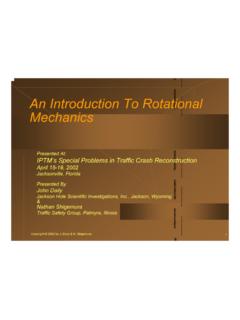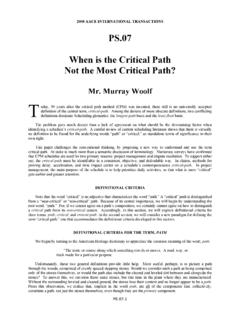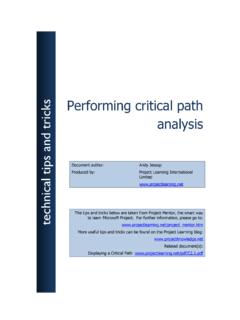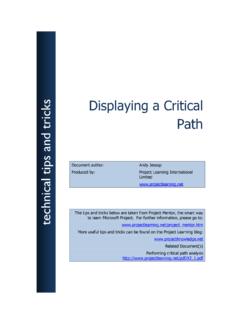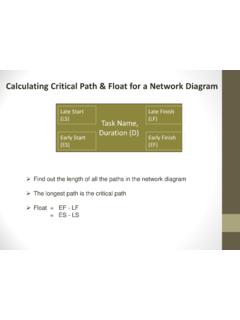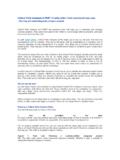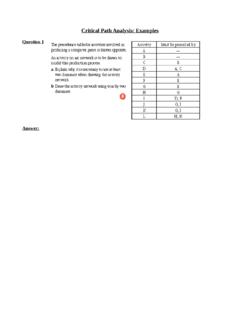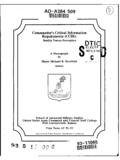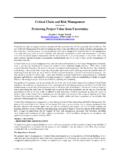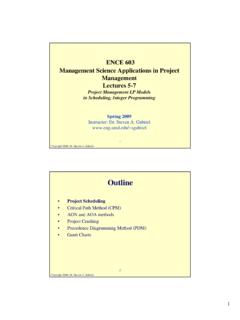Transcription of Critical Speed Yaw Analysis and Testing - jhscientific.com
1 Critical Speed YawAnalysis and TestingPresented by:John DailyJackson Hole Scientific Investigations, 2206 Jackson, WY 83001 Critical Speed Yaw What is a yaw ? What does the word Critical mean? How do we get Speed out of this?Definitions Yaw refers to the orientation of the vehicle. Specifically, the heading of the vehicle is not co-linear with the velocity vector of the vehicle. The evidence showing this are the tire scuffs on the road. The rear tires track outside the corresponding front , cont d. Critical refers to the idea that we may identify the lateral acceleration as the maximum dynamicfriction on the road. We obtain this friction information with a test skid. We may have to correct our test skid information for grade or superelevation. The ONLY way a vehicle gets onto a Critical Speed yaw is through the application of an inappropriate steering input (over correction)! Speed Calculation To determine a Speed from a Critical Speed yaw situation, we need the radius of the curved path of the vehicle center of mass and the lateral acceleration of the vehicle.
2 Lateral acceleration comes from skid Determination In order to obtain a path radius, we first measure a chord of the arc left by the outside front tire. A chord is any line that cuts the arc at two points. The chord beginning is right after the rear tire mark crosses over the front tire mark. Chord lengths should be between 30 and 50 Determination, cont d. After we have laid down the chord measurement, we have to determine a middle ordinate. The middle ordinate divides the chord in half and extends out to far the edge of the tire mark. For a 30 foot chord, measure the middle ordinate to the nearest 1/8 Determination, cont d. Once we have chord and middle ordinate measurements, we may calculate the radius of the outside front tire mark with the following equation: To get the CM radius, subtract of the track width from this +=Skid Testing In order to get the proper drag factor for a Critical Speed calculation, we must do test skids. Results between tests must be consistent.
3 The following tests were conducted at the Wisconsin State Patrol Academy in August Skid Tests Two vehicles were used to develop drag factor data A 2002 Pontiac Grand Prix was used to gather ABS braking data A 1997 Ford Crown Vic was used for both ABS and non-ABS Testing A VC-2000 accelerometer was used to gather the drag factor data The accelerometer data was graphed with data points every seconds The accelerometer was in the AutoStartmode, with a default acceleration setting of Test Skids, cont d Investigators identified and measured the skid marks from the test vehicles The whole length of the skid marks were difficult to pick up visually An LTI Laser with a polarizer was used to assist in determining visual skid length These enhanced data correlated better with the skid length as reported by the VC-2000 The rear brakes of the Ford did not lock up when the ABS was disabled Hence, we were not able to get a true sliding drag factor for this surface The drag factor was for the Ford onlyClose-up of Sliding Contact PatchSpackling indicates the tire is braking at or near Test Datawith (VC) Time (VC) G (VC) G (VC) (VC)724750464946n/aRadar7654321 Test NumberDeceleration Factor Testsfor 1997 Ford Crown Victoria with ABS (sec)G or fw/o ABS(1)w/o ABS(2)1997 Crown Vic TestsRear Brakes did not lock upDeceleration Factor Testsfrom VC2000 Accelerometer for 2002 Pontiac Grand (sec)G or fTrial 1 Trial 2 Trial 3 All Pontiac ABS TestsDeceleration Factor Test1997 Ford Crown Victoria with ABS (sec)G'sDrag FactorAverageTest skid from 73 mphAcceleration Factor Testsfrom VC2000 (sec)G or fTrial 1 Trial 2 Trial 3w/ ABSw/o ABS(1)w/o ABS(2)
4 Hi speedAll Test SkidsRoad EvidenceIn order to properly analyze a Critical Speed yaw situation, we must recognize the tire mark evidence left the diagonal striations and uneven edge of the tire marks left in the following photos. The rear tires begin tracking outside the front GradeMeasuring Super-elevationYaw Marks (Scuffs) Tire is sliding and rotating A yaw results when the velocity vector and heading of the vehicle are not co-linear. If the yaw is the result of inappropriate steering input, then the yaw may be a Critical Speed Yaw , and may be used for Speed Analysis in a simple, straightforward manner. This photo illustrates a Critical Speed yaw. Notice the rear tires track outside the corresponding front Marks, Cont d. This crash began with Critical Speed yaw marks on the shoulder We can use shoulder drag to get a conservative Speed estimate. We may average shoulder and road drag to get an upper limit Marks, Cont d. The Yaw begins to transition to a side skid.
5 We may no longer treat it as a Critical Speed yaw. We will see later in the presentation how to deal with a Marks, Cont d. Another example of transitioning yaw marks- If these marks were analyzed as Critical Speed yaws, the speeds would be way off probably on the high Marks, Cont d. This is a curving tire mark, but does not indicate a yaw. This is a curving acceleration scuff. Other curving marks may also look like Critical Speed yaws, but are not. Is there a way to examine this question? Critical Speed Yaw? We need a tool we can use to determine if the vehicle is actually in a Critical Speed yaw. If we look at the dynamics of a vehicle in this maximum steering situation, we would expect the vehicle to decelerate longitudinally as it progresses through the yaw. If we can quantify this deceleration at a nominal value, then we may look at any particular case and determine if its deceleration fits into the model. Much Testing over the years suggest a nominal value for yaw deceleration on a dry, hard-surfaced road, is about Speed Yaw?
6 Cont d. If we measure two chords and two middle ordinates, we may calculate two radii. If the second chord is measured from the end of the first chord, we may calculate the difference in radius between the first chord and the second chord. The second radius calculated should be smaller than the first if the vehicle is Speed Yaw? cont d. Calculate a Speed for each radius. Use the following equation to determine the deceleration in the yaw: The distance din the equation is from one middle ordinate to the = Critical Speed Yaw Test Wisconsin Results The Ford was put into a Critical Speed yaw at 33 mph as measured by Radar The VC-2000 was set in continuous mode to measure the longitudinal deceleration factor The longitudinal deceleration was to A chord and middle ordinate was measured when the rear tire began tracking outside the corresponding front tire A second chord and middle ordinate was measured from the end of the first chordCritical Speed Yaw Test, cont d A radius was calculated for each chord If the vehicle is in a true Critical Speed yaw, there should be a reduction in Speed from the first radius to the second radius We will calculate the Speed using the standard Critical Speed yaw equation and the drag factor from the Ford Because the rear wheels of the Ford did not lock up, this Speed calculation will be low A second Speed calculation.
7 Using the average ABS drag factor for the Ford, results in a Speed within one mph of the Radar Speed measurementCritical Speed Equations282mmcR+= Radius Equation Critical Speed Yaw Equation Longitudinal Drag Factor = Critical Speed Yaw DataObserved Deceleration: ft 6" 3 3/8" '11"Track widthmph33 Initial Speed on radarSummary of Critical Speed Yaw Calculations Corrected Radius 1: feet Corrected Radius 2: feet Initial Speed 1; f = : mph Initial Speed 1; f = : mph Final Speed 2; f = : mph Final Speed 2; f = : mph Longitudinal Drag Factor: calculatedCritical Speed Yaw Tests Minnesota Patrol Academy 2003 The Crown Vic was put into a Critical Speed yaw at 38 mph as measured by Radar. The VC-3000 was set in braking mode. The x-axis (longitudinal) deceleration was at the beginning of the yaw. A chord and middle ordinate was measured when the rear tire began tracking outside the corresponding front tire A second chord and middle ordinate was measured from the end of the first chordCritical Speed Yaw Test, cont d A radius was calculated for each chord If the vehicle is in a true Critical Speed yaw, there should be a reduction in Speed from the first radius to the second radius.
8 We will calculate the speeds using the standard Critical Speed yaw equation and the drag factor from the Taurus, which was a non-ABS Speed Yaw Test, cont d The Taurus was put into a Critical Speed yaw at 36 mph on the Radar. Its evidence was analyzed in the same way as the evidence from the Crown Speed Equations282mmcR+= Radius Equation Critical Speed Yaw Equation Longitudinal Drag Factor =Summary of Critical Speed Yaw Calculations Crown Vic Corrected Radius 1: feet Corrected Radius 2: feet Initial Speed 1; f = : Final Speed 2; f = : Longitudinal Drag Factor: X-axis deceleration measured: Radar Speed : 38mphSummary of Critical Speed Yaw Calculations Taurus Corrected Radius 1: feet Corrected Radius 2: feet Initial Speed 1; f = : Final Speed 2; f = : Longitudinal Drag Factor: X-axis deceleration measured: Radar Speed : 36mphCritical Speed Yaw Test Montgomery, OH (July 2003) The Malibu was put into a Critical Speed yaw at 30 mph as measured by Radar The VC-3000 was set in continuous mode to measure the lateral and longitudinal acceleration factors The VC-3000 integrated Speed was The longitudinal deceleration factor was after the initial hard right steer.
9 A chord and middle ordinate was measured when the rear tire began tracking outside the corresponding front tire A second chord and middle ordinate was measured from the end of the first chordCritical Speed Yaw Test, cont d A radius was calculated for each chord. If the vehicle is in a true Critical Speed yaw, there should be a reduction in Speed from the first radius to the second radius We will calculate the Speed using the standard Critical Speed yaw equation and the drag sliding drag factor from the Ford The rear wheels of the Ford did not lock, so the average used was , which is between the ABS average of and the sliding average of Speed Equations282mmcR+= Radius Equation Critical Speed Yaw Equation Longitudinal Drag Factor = Speed from Accelerometer:mph30 Initial Speed on of of Tire of of Tire markft30 Chord1* From Ford Crown Victoria test WITHOUT Track* widthCritical Speed Yaw AnalysisCritical Speed Yaw of 2003 Chevy Malibu(VC3000 Computer) 'sLongitudinalLateralPost Yaw BrakingInitial value as calculated: Speed Yaw Tests Wyoming Academy October 2003 Tests were conducted during a TCR Update course at the Wyoming Law Enforcement Academy.
10 The vehicle used was a 1989 Chevrolet Caprice police package vehicle. Test skids were done with this vehicle on a level portion of the test track. The average for this vehicle with standard brakes was Tests, cont d The vehicle was put into a Critical Speed yaw at 46 mph as measured by Radar. Two 30 foot chords were measured, with middle ordinates of ft and ft respectively. The two corrected radii were ft. and ft, respectively. The super-elevation at the middle ordinate points was The corrected lateral acceleration factor, f, was Wyoming Tests, cont d. The Speed calculated from the first radii was The Speed calculated from the second radius was mph. The calculated deceleration was The accelerometer measured deceleration was Tests, cont d. A second Critical Speed test was conducted at a Radar measured Speed of 33mph. Using a similar Analysis to the previous example, the initial Speed was calculated at and the second Speed was mph. The calculated deceleration The accelerometer measured deceleration was if it s a Spin?
